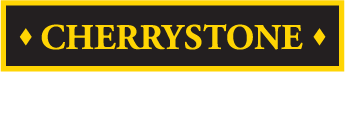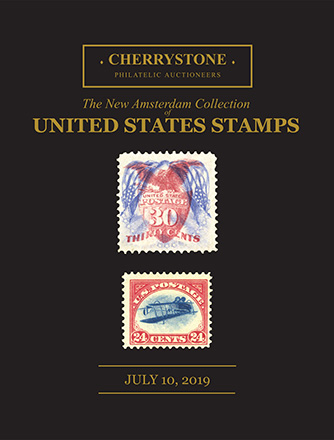The New Amsterdam Collection of United States Rarities
July 10, 2019
The New Amsterdam Collection of United States Stamps sold for close to $7 Million on 10th July 2019. Hundreds of floor and internet bidders competed for just 220 lots at auction which took almost four hours to complete. With the final hammer, the New Amsterdam Collection took its rightful place among the most valuable stamp collections in philatelic history.
The New Amsterdam Collection was formed over fifty years ago, its mission to complete spaces in a newly acquired Scott National Postage Album. Most of the material was acquired through Dumont Stamp Company, an old established and respected dealership which was in midtown Manhattan in the 1970s.
Competition was intense, especially for the top items. The absolute highlights of the auction were the two 1867 "Z" Grills, each with a pre-sale estimate of $750,000. The 10c green (Washington) fetched $1,150,000 and 15c gray black (Lincoln) $1,610,000, the latter setting a record for a single United States stamp sold at auction.
Additional rare Grills realized $661,250 for a 3c "B" Grill and $172,500 for a 30c "A" Grill. Other noteworthy results include $287,500 for 1869 30c Pictorial with Inverted flags and $402,500 for 24c Inverted Jenny. A rare 2c coil pair estimated at $300,000 was hammered down at $805,000. All results include Cherrystone's 15% buyer's premium.
| Images | Description | Current Bid |
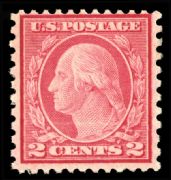 | Lot #194
United States 1917-29 Issues
1919 2c carmine rose, Type II, Rotary, perf 11 x 10, h.r., tiny gum soak on gum only, usual centering, beautiful bright color, fresh and fine, with 2019 PFC,
*
Catalog #539
Catalog Value $2,700 | Price Realized
$2,100.00
|
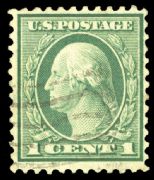 | Lot #195
United States 1917-29 Issues
1922 1c green, Rotary, perf. 11, very light wavy lines machine cancel leaving clearly visible design, well centered for this difficult stamp, tiny perf. Creases of no importance, pencil signed, fine and very rare Rotary Perf. 11 single, with 2019 PFC (Most of the recorded copies of Scott 544 are poorly centered or damaged, due to poor production standards and mishandling),
O
Catalog #544
Catalog Value $3,500 | Price Realized
$1,500.00
|
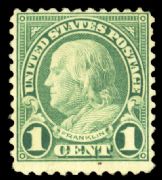 | Lot #196
United States 1917-29 Issues
1923 1c green, Rotary, perf. 11, unused without gum, well centered for this difficult issue with perfs clear (often found with perfs in), small paper flaw and a tiny natural inclusion at bottom, fine, with 1961 and 2019 Philatelic Foundation Certificates. One of the rarest 20th Century United States stamps in unused condition (594 is waste from a horizontal rotary printing used to make coils. At the beginning or end of a coil-stamp print run from the 170-subject rotary plates, some leading or trailing paper was produced that was too short for rolling into 500-stamp rolls. In 1919 the Bureau devised a plan to salvage this waste by perforating and cutting the sheets into panes. They were put through the 11-gauge flat-plate perforator in use at the time, giving the sheets full perforations on all sides. The existence of Scott 594 was not reported until four months after the final sheets were delivered, and the 1c Rotary perf. 11 was soon recognized as one of the rarest United States stamps. Siegel Census of unused examples of Scott 594 records only 18 (!) copies. Of these only 11 have any gum, and three of those have perforated initials of Crowell Publishing Co. of Springfield, Ohio, which some collectors regard as equivalent to a cancel. The example offered here is Census No. 594-OG-05 (Scott Catalogue notes "both unused and used are valued with perforations just touching frameline on one side") (catalogued as unused without gum)
(*)
Catalog #594
Catalog Value $35,000 | Price Realized
$10,000.00
|
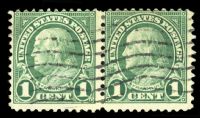 | Lot #197
United States 1917-29 Issues
1923 1c green, Rotary, perf. 11, used horizontal pair, wavy line machine cancel, usual centering, left stamp with a sealed tear at top left (right stamp sound), with 1955 and 2019 Philatelic Foundation Certificates. There are only four known pairs. One of the rarest 20th Century United States stamps in unused condition (the 1c green, Scott 594, is waste from a horizontal rotary printing used to make coils. At the beginning or end of a coil-stamp print run from the 170-subject rotary plates, some leading or trailing paper was produced that was too short for rolling into 500-stamp rolls. In 1919 the Bureau devised a plan to salvage this waste by perforating and cutting the sheets into panes. They were put through the 11-gauge flat-plate perforator in use at the time, giving the sheets full perforations on all sides. The existence of Scott's 594 was not reported until four months after the final sheets were delivered, and the 1c Rotary perf. 11 was soon recognized as one of the rarest United States stamps (Siegel Census 594-CAN-PR-03, not seen since 1955)
O
Catalog #594
Catalog Value $25,000 | Unsold
|
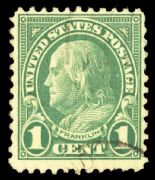 | Lot #198
United States 1917-29 Issues
1923 1c green, Rotary, perf. 11, light machine cancel, fresh color, trivial short perforation at bottom right, otherwise fine, ex-Grunin, with 1963 and 2019 Philatelic Foundation Certificates. Of the 15 known examples (all used), only five have machine cancels (the other ten have "Kansas City, MO" precancels) and only two are completely sound (the other two have varying degrees of faults, far more significant than the "short perf" mentioned here). This stamp is listed in the Siegel Census as 596-CAN-03. A major 20th Century U.S. Rarity, valued in Scott catalogue in the grade of fine,
O
Catalog #596
Catalog Value $200,000 | Price Realized
$100,000.00
|
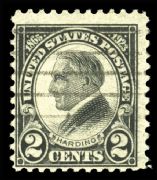 | Lot #199
United States 1917-29 Issues
1923 2c black, Rotary perf. 11, machine cancel, fine, completely sound, with 1958 and 2019 Philatelic Foundation Certificates. Warren G. Harding, the 29th President, died in San Francisco on August 2, 1923 and a Harding memorial stamp, printed in black was rushed into production. The first flat plate printing (Scott 610) was issued on September 1, 1923 in his home town of Marion, Ohio, followed less than two weeks later by the normal perf. 10 rotary press printing (Scott 612) on September 12. The 2c Harding Rotary perf. 11 stamp was discovered in 1938 by Leslie Lewis of the New York firm, Stanley Gibbons Inc. Gary Griffith presents his hypothesis in United States Stamps 1922-26, that rotary-printed sheets of 400 were first reduced to panes of 100 and then fed through the 11-gauge perforating machine normally used for flat plate sheets,
O
Catalog #613
Catalog Value $40,000 | Price Realized
$19,500.00
|
